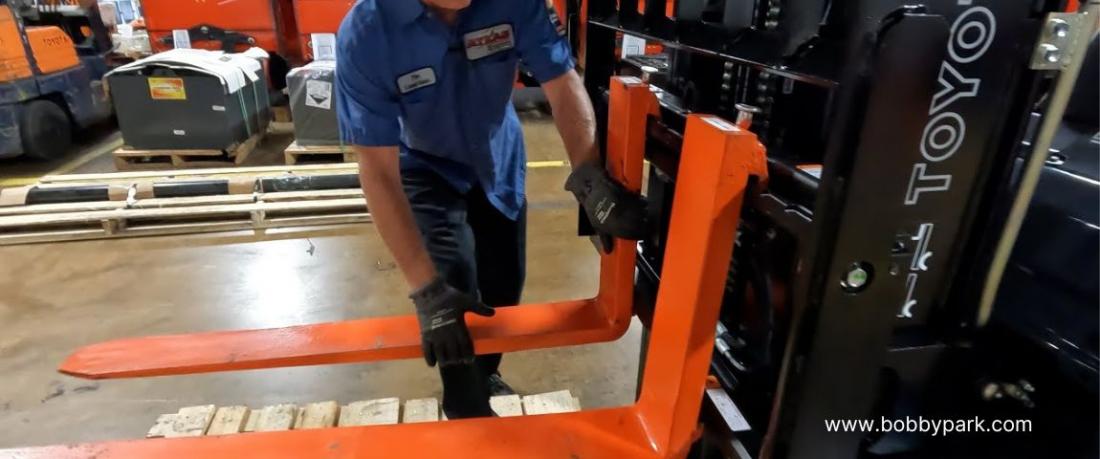HOW TO MOVE FORKLIFT FORKS? THE PROCESS OF REMOVING AND INSTALLING

Forklifts play a crucial role in warehouses and industrial settings. Their effectiveness relies on properly maintained and functional forks. Understanding forklift fork movement and how to replace them is essential for smooth operations. This guide by our Bobby Park Truck and Equipment experts will walk you through the process, offering expert advice and precautions to ensure a seamless transition.
Explaining Forklift Fork Movement
Fork movement involves raising or lowering the forks to adjust for load height. This is achieved by activating the hydraulic system, which extends or retracts the forks, allowing for precise positioning under the load.
What Steps Are Involved in the Proper Forklift Fork Movement?
Clients should know about the following steps taken to ensure proper fork movement.
Safety Precautions
Forklift safety measures should always be the top priority when working with heavy machinery like forklifts that you have purchased from a used truck dealer. Before you begin, make sure to:
-
Clear the area of any obstructions.
-
Wear appropriate safety gear, including gloves and safety goggles.
-
Ensure the forklift is turned off and the keys are removed.
Tools Required
-
Wrenches (adjustable and socket)
-
Safety gloves
-
Replacement forks
-
Block of wood (for supporting the forklift)
Procedure
-
Disconnect the Battery: Disconnect the forklift's battery to prevent accidental starts.
-
Stabilize the Forklift: Use the wood block to support the forklift and prevent it from tilting.
-
Remove Locking Pins: Use a wrench to remove the locking pins securing the forks in place.
-
Detach the Forks: Carefully slide the old forks out from their position.
-
Install New Forks: Slide the new forks into the designated slots and secure them with locking pins.
Gathering Tools
Having the right tools at your disposal can make the process much smoother. Our heavy-duty truck and forklift dealer will help you with gathering the tools.
Required Tools
-
Wrenches (adjustable and socket)
-
Safety gloves
-
Replacement forks
-
Block of wood (for supporting the forklift)
Removing Old Forks
Before you begin, ensure you have taken all safety precautions. Here's how you remove old forklift forks:
Procedure
-
Disconnect the Battery: Disconnect the forklift's battery to prevent accidental starts.
-
Stabilize the Forklift: Use the wood block to support the forklift and prevent it from tilting.
-
Remove Locking Pins: Use a wrench to remove the locking pins securing the forks in place.
-
Detach the Forks: Carefully slide the old forks out from their position.
Adjusting Height
Properly adjusting the height of the forklift forks is crucial for efficient operations. Our used commercial truck dealer will follow these steps:
Procedure
-
Locate Height Adjustment Mechanism: It's usually found near the base of the forks.
-
Loosen the Adjusting Nut: Use an adjustable wrench to loosen the nut.
-
Raise or Lower the Forks: Adjust as needed.
-
Tighten the Nut: Once in the desired position, tighten the nut securely.
Testing by Used Trucks and Forklift Dealer
Before putting the forklift back into regular use, it's essential to conduct some tests.
Procedure
-
Inspect the Forks: Ensure they are securely in place.
-
Start the Forklift: Reconnect the battery and start the forklift.
-
Lift and Lower: Test the forks by lifting and lowering them.
-
Check for Stability: Ensure the forks remain stable during operation.
Common Issues
Knowing the common problems associated with forklift forks can save you time and money. Here are a few to watch out for:
1. Misalignment
-
Issue: Forks are not parallel or properly aligned.
-
Solution: Realign the forks and secure them with locking pins.
2. Wear and Tear
-
Issue: Forks show signs of wear, such as bending or cracking.
-
Solution: Replace with new forks.
Maintenance Tips
Maintenance tips for a Moffet forklift are as follows:
1. Lubrication
-
Frequency: Every 100 hours of operation.
-
Procedure: Apply lubricant to all moving parts.
2. Visual Inspections
-
Frequency: Before each use.
-
Procedure: Check for signs of wear or damage.
Knowing how forklift fork movement is done and how to replace forklift forks is essential for maintaining a safe and efficient warehouse environment. By following the steps outlined in this guide, you can ensure your forklifts continue to operate smoothly. You can contact our trusted truck dealer experts by visiting our website.
Frequently Asked Questions
Q1: How often should forklift forks be replaced?
Forks should be replaced when they show signs of wear, such as bending or cracking. This determines if forklift fork movement is required.
Q2: Can I install forklift forks without professional help?
It's recommended to seek assistance from a trained technician to ensure proper installation.
WHY CHOOSE US?
- Full Parts and Service Shop
- State of the Art Paint Shop
- Body Work
- Van bodies, reefer bodies, Flatbed bodies and Storage Containers available
- Tuscaloosa and Jackson Locations
- Ships anywhere in the United States

